
By the early 1930s, many Syracusans, and Americans, had enough of prohibition. The Association Against the Prohibition Amendment (AAPA) was formed in 1918 by William H. Stayton and was “the leading political pressure group helping to secure repeal of the Eighteenth Amendment to the U.S. Constitution.” Despite not being able to block the 18th Amendment, or the Volstead Act, Stayton continued to keep the organization going. The AAPA was incorporated and was claiming over 500,000 membrs by the mid-1920s. A reorganization helped the AAPA grow its support on a local and national level. Recruits included John J. Raskob (Developer of the Empire State Building and Financial Executive for General Motors) and James W. Wadsworth (New York State Senator – R) among others.
On May 14th, 1932, Syracuse was home to an enormous anti-prohibition parade and protest. The center of attention was the 11ft tall statue of Gambrinus, a mythical patron saint of beer who was also the figurehead of the Haberle Brewery (now on display at the Onondaga Historical Museum). Gambrinus was carried on the back of a railroad car in front of one of the largest crowds to assemble in downtown Syracuse and even stood their ground through two thunderstorms. The organizers of this parade had invited the entire city, county, and legislative officials to witness the peoples’ displeasure of the Volstead Act. However, only a handful showed up, among them was Syracuse Mayor, Rolland B. Marvin. The parade weaved through downtown Syracuse with multiple meeting points around the city at major intersections, such as West Genesee and Erie Boulevard.
Syracuse Judge William S. Andrews, who was in South America at the time, said in a Syracuse Journal article that the end of prohibition was “the most important matter before the American people today. We lost great revenues which would go far to relieve distress. We lost means of employment. We lost markets for the crops of our farmers.” Andrews went on to say, “Crime is financed like never before. Our courts are clogged. Our children drink as an adventure. Temperance is a question of education. It cannot be enforced by statute.”
As support for repeal grew, and with the election of new leadership in Washington, legislation to end Prohibition was written. Both the the Cullen-Harrison Act and the Blaine Act were introduced in early 1933. Officially, the end of prohibition came with the 21st Amendment to the Constitution, which was ratified on December 5, 1933.
As Judge Andrews also mentioned in his quote in the Syracuse Herald, “…prohibition has been a failure as well as an evil.”
In Syracuse, no large celebrations were held to welcome the end of Prohibition, although the following day there were quite a few Syracusans out enjoying their new freedom. After prohibition ended, many of the Syracuse breweries started up again, but it was a long road to recovery and business was never quite the same.
In reality, it was the beginning of the end for local breweries until the recent resurgence, which includes Middle Ages Brewery, Empire Brewery, Willow Rock, and many others.

